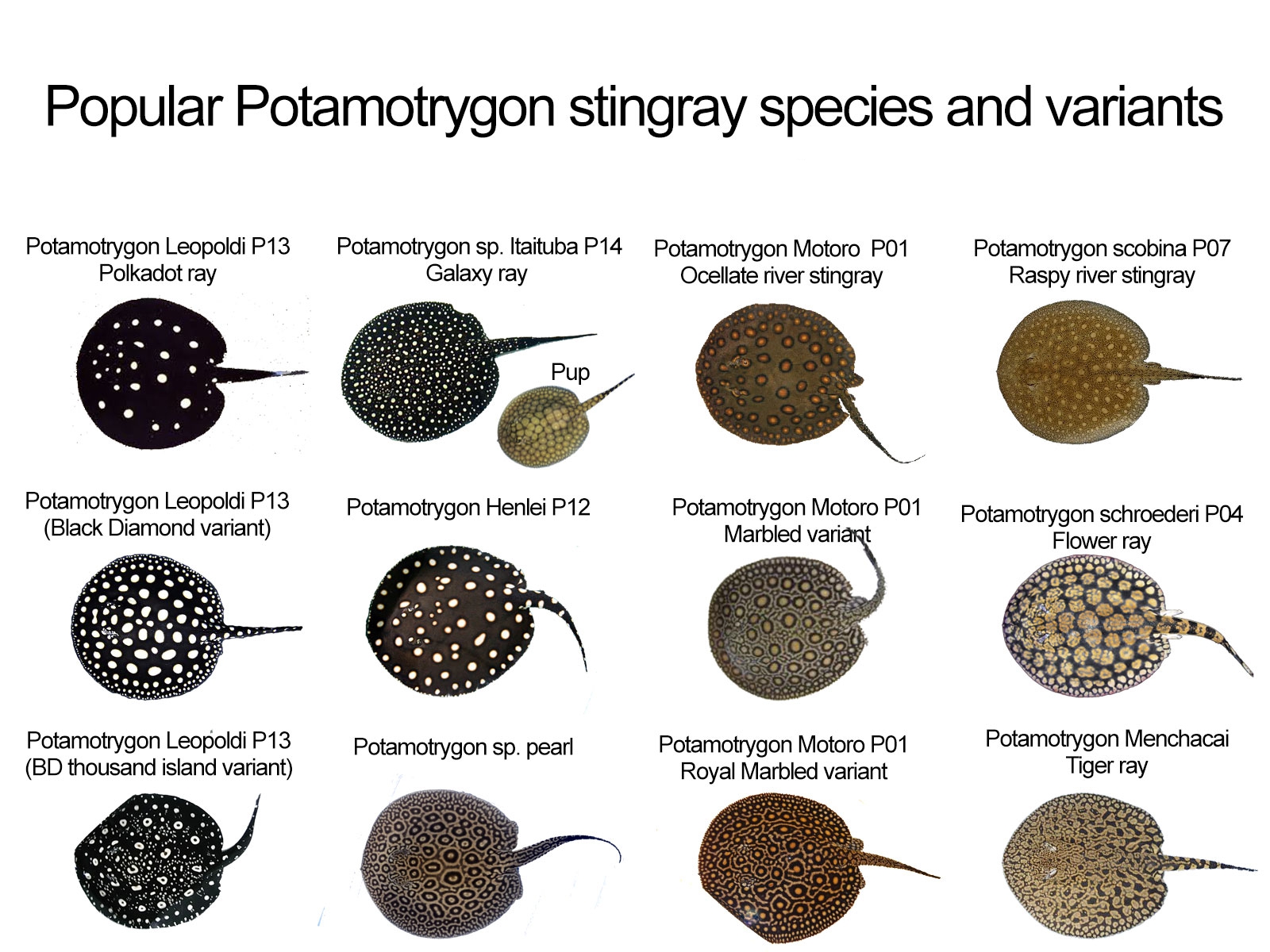Stingrays are a family of fish, primarily composed of cartilage, that are closely related to sharks and are characterized by their flattened bodies and long tails, which are sometimes equipped with a defensive spine. What are the Types of Stingrays?
Saltwater
- Southern Stingray-Atlantic Stingray
- Eagle Ray-Cow-nosed Ray
- Blue-spotted Ribbontail-Black-blotched Stingray
- Leopard Whipray-Manta Ray
Freshwater
- Motoro Stingray-Amazon Stingray
- Potamotrygon Stingray-Hystrix Stingray
- Ocellate River Stingray-Teacup Stingray
- White-blotched River Stingray-Black Diamond Stingray
Shared Characteristics
1. Disc-Shaped Bodies
- Both saltwater and freshwater stingrays have disc-shaped bodies, which contribute to their efficient movement in water. This distinctive shape aids in their ability to glide gracefully along the ocean or river floor.
2. Whip-Like Tails
- A prominent feature of all stingrays is their long, whip-like tails. These tails are used for self-defense, navigation, and in some cases, for burying themselves in the substrate.
3. Coloration and Patterns
- Stingrays, whether in saltwater or freshwater, exhibit a wide range of colors and patterns. These markings often serve as a form of camouflage, helping them blend into their natural environments.
Saltwater Stingrays:
a. Bluespotted Ribbontail Stingray (Taeniura lymma)

- Recognized by striking blue spots on a yellowish-brown background.
- Inhabits the Indo-Pacific region, including the Red Sea and East Africa.
- Often found in coral reef environments.
b. Southern Stingray (Dasyatis americana)
- Features a diamond-shaped disc and a long, whip-like tail.
- Inhabits warm coastal waters of the western Atlantic, from the Chesapeake Bay to Brazil.
- Frequently seen in sandy or muddy bottoms.
c. Round Stingray (Urobatis halleri)
- Small and round-shaped with a plain coloration.
- Commonly found in the eastern Pacific, from Oregon to Baja California.
- Inhabits shallow coastal waters.
Freshwater Stingrays:
a. Potamotrygon Species
- Popular in the aquarium trade with circular markings on their disc.
- Primarily found in freshwater rivers and tributaries in South America.
- Requires a sandy substrate in captivity.
b. Paratrygon Species
- Known for large disc sizes and intricate patterns.
- Native to freshwater habitats in South America.
- Benefits from a soft substrate and spacious tank.
c. Urogymnus Species
- Among the largest freshwater stingrays with expansive disc sizes.
- Inhabits freshwater rivers with robust swimming patterns.
- Requires a massive tank size for optimal care.
What are Stingray’s Behavior
1. Bottom-Dwelling:
- Both saltwater and freshwater stingrays are primarily bottom-dwelling species, often burying themselves in the substrate to camouflage and hide from potential predators.
2. Digging Behaviors:
- Stingrays, especially in freshwater, exhibit digging behaviors in sandy substrates. They use their pectoral fins to create pits and search for food.
3. Camouflage:
- The coloration and patterns of stingrays serve as effective camouflage, allowing them to blend seamlessly with their surroundings and avoid detection by predators.
4. Social Behaviors:
- Freshwater stingrays, in particular, are known for their social behaviors. They thrive in groups, and interaction with tank mates is crucial for their well-being.
In conclusion, while saltwater and freshwater stingrays share certain fundamental characteristics, their specific adaptations and behaviors are influenced by the distinct environments they inhabit. Understanding these differences is essential for providing optimal care in aquarium settings and appreciating the diversity within the fascinating world of stingrays.
Conservation Considerations
While many stingray species are popular in the aquarium trade, it’s crucial to consider conservation efforts. Some species face threats due to overfishing and habitat destruction. Responsible and sustainable practices in the aquarium hobby contribute to the preservation of these captivating creatures.
The world of stingrays encompasses a rich diversity of species, each adapted to its specific freshwater or saltwater habitat. Understanding their characteristics, habitats, and conservation needs enhances the appreciation and responsible care of these remarkable creatures in both aquariums and their natural environments. Both saltwater and freshwater stingrays share some common characteristics and behaviors but they also exhibit variations based on their respective habitats. Here’s an overview:
Conservation considerations are crucial for the well-being and preservation of stingray species. Overfishing and habitat destruction pose significant threats to both saltwater and freshwater stingrays, impacting their populations in the wild.
Responsible and sustainable practices in the aquarium trade, such as captive breeding programs, can help reduce the demand for wild-caught specimens. Additionally, supporting conservation initiatives that focus on protecting the natural habitats of stingrays is vital for ensuring the continued existence of these remarkable creatures. Education and awareness about the importance of stingray conservation play a pivotal role in inspiring individuals and communities to contribute to efforts aimed at safeguarding these species for future generations.

References:
Animal Habitat-Stingray – Description, Habitat, Image, Diet, and Interesting Facts (animals.net)
FAQ’s
Do all stingrays have stingers?
Not all stingrays have stingers, but many species do. The stinger, or barb, is usually located at the base of the tail. It contains a venomous substance that can be injected into potential threats.
Are stingrays dangerous to humans?
While most stingrays are not aggressive towards humans, they can become defensive if stepped on or threatened. The barb on their tails can cause injury, and in rare cases, the venom may be harmful.
How should I avoid stingray injuries?
When wading in shallow waters, shuffle your feet to alert stingrays of your presence and avoid stepping on them. Stingrays are generally not aggressive and will swim away if they sense your approach.
What should I do if I get stung by a stingray?
If stung, it’s important to clean the wound with warm water and seek medical attention. The wound may require treatment to remove the stinger and address any potential complications from the venom.
Where are stingrays commonly found?
Stingrays inhabit various environments, including coral reefs, sandy bottoms, and estuaries. Some species are adapted to freshwater habitats, while others are found in saltwater.





